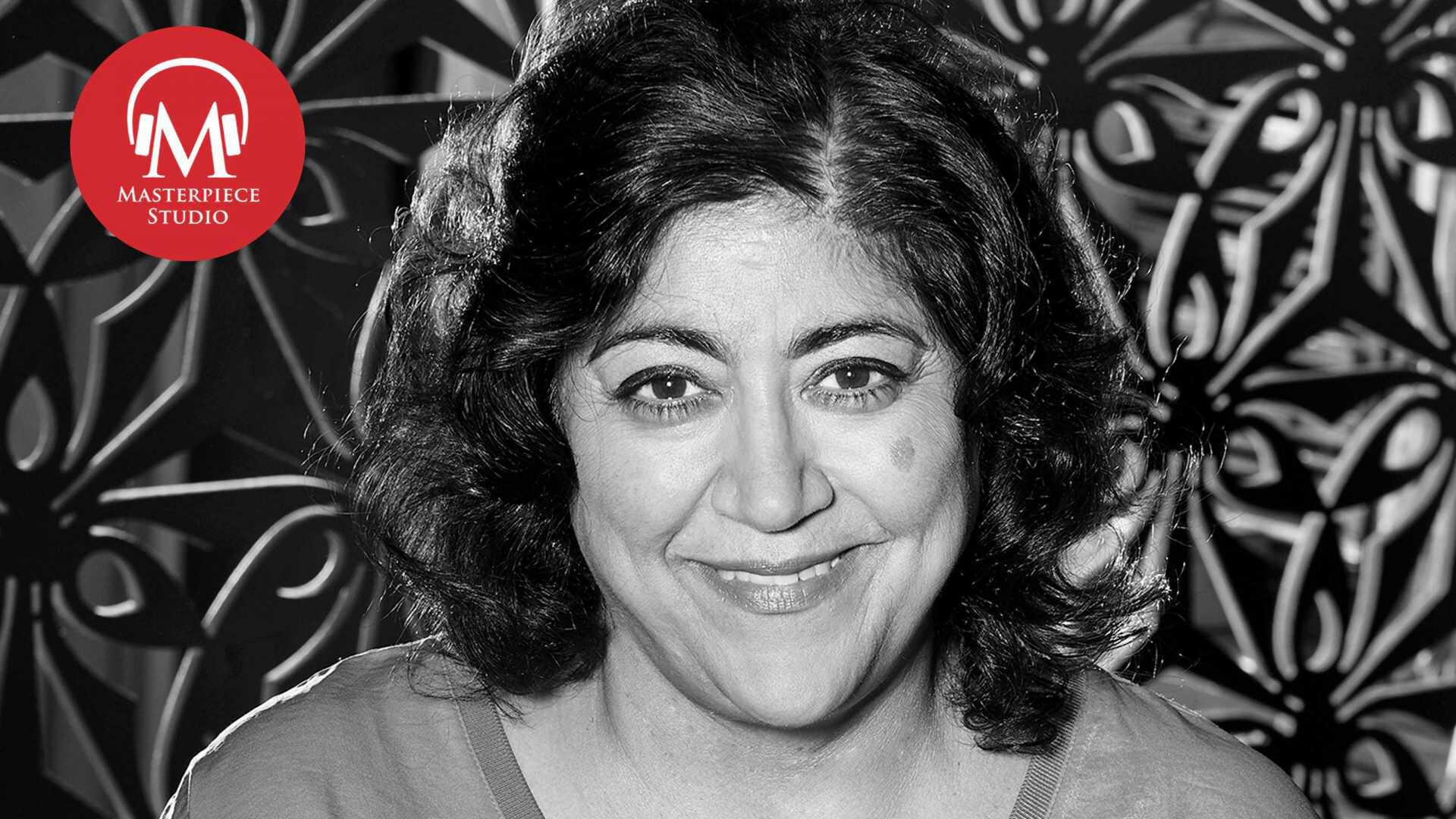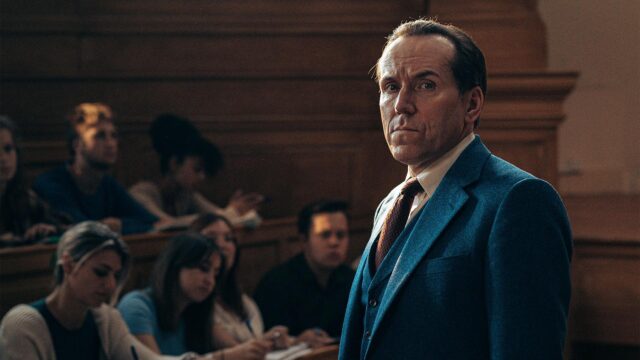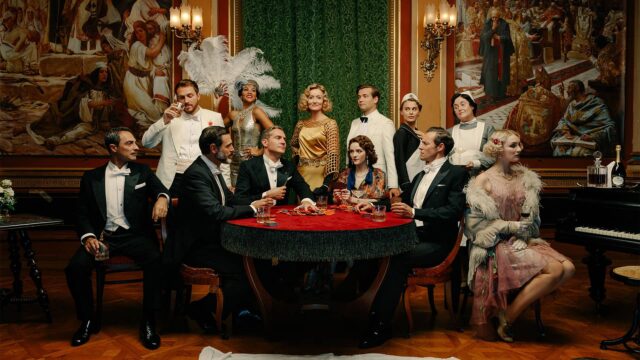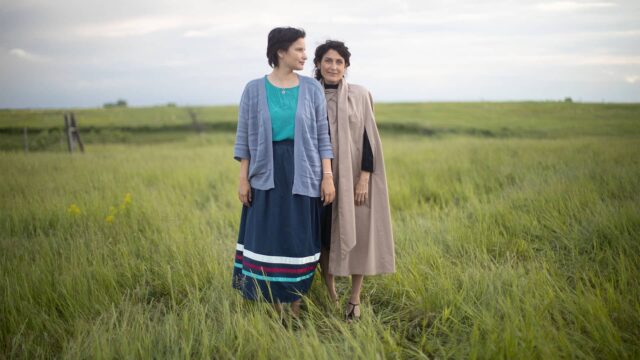Fillmmaker Gurinder Chadha brings a keen eye to her multigenerational Indian drama, Beecham House. And the family story isn’t just in front of the camera — her husband, Paul Mayeda Berges, created and produced the series with her, and the couple’s twins appear as royal characters. The entire historical costume drama is now available for binge viewing on PBS Passport, and Chadha previews the story for MASTERPIECE viewers in a new podcast conversation.


Bonus: Gurinder Chadha’s ‘Beecham House’ Is A Family Affair
Download and subscribe on: iTunes | Spotify| RadioPublic
Transcript
Barrett Brountas: I’m Barrett Brountas, and you’re listening to MASTERPIECE Studio.
Gurinder Chadha is perhaps best known to American audiences for her smash-hit 2002 soccer league rom-com, Bend It Like Beckham, or her more recent Bruce Springsteen-inspired musical biopic, Blinded By The Light.
For MASTERPIECE viewers, however, Chadha might soon be best known for her thrilling new drama — Beecham House.
CLIP
John Beecham General, India belongs to neither the British nor the French.
Gen. Castillon If the French departed there would be no one to stop the British from taking all of India, yes?
John Beecham General, I am not like my countrymen.
Barrett The series, centered in a grand house in Delhi of the 1790s, stars Tom Bateman as the dashing John Beecham, a reformed former soldier of the East India Trading Company with plenty of secrets.
CLIP
Baadal No one mentioned a baby is coming, Saheb?
John Beecham Baadal, you will learn that I am a private man. Now I should like to see the house.
Barrett The series stars MASTERPIECE favorites like Downton Abbey’s Lesley Nicol, Sanditon’s Leo Suter and Endeavour’s Dakota Blue Richards.
CLIP
Henrietta I dreamt of the time we would be together again, I feared it would never come, I had lost you to India forever. How much I have missed you
Barrett And starting March 1, you can watch the entire Beecham House series on PBS Passport, a member benefit from your local PBS station. To learn more, visit pbs.org/getpassport.
Beecham House will air on PBS later in 2020, but while we wait, we thought we would treat our listeners and viewers to a special interview with Beecham House creator Gurdinder Chadha, who can offer a preview of the series — and maybe entice you to binge the whole thing on Passport!
And we’re joined this week by Beecham House creator, writer, director and executive producer, Gurinder Chadha. Welcome!
Gurinder Chadha Hello. Nice to be here.
Barrett So nice to have you. Thank you. So you are the visionary behind the groundbreaking 2002 film Bend It Like Beckham and more recent feature films including Viceroy’s House and Blinded by the Light. So how did you decide to take the plunge into making a TV series for Beecham House?
Gurinder Well, as you mentioned, Viceroy’s House was the big film that I had always wanted to make about the end of British rule in India. And it was set in 1947. And the Viceroy, of course, was Lord Mountbatten, the Queen’s uncle. And the story really affected my family because my family were originally from the part of India that became Pakistan and like millions of others, became refugees overnight, as it were, and had to flee for their lives. And so Viceroy’s House was looking at what was actually going on behind the scenes as to why decisions were made as they were to divide India. And in making that, it was a very sumptuous political drama, all shot in India, virtually. I got the bug really and thought, why not go right back to the beginning of the Raj here? Viceroy’s House is the end. Why not go back to the beginning, when it was a little bit like the Wild West out there and and create a series that looks at the relationship between Britain and India and of course the rest of the world as as we find out, all affected? And that’s when I came up with the idea of circling around a house, Beecham House. And so the house remains over the next, what, five, 150, 200 years. But the families, Beecham family in particular and their servants, you know, they change. So the idea was to create something that had, I guess, a little bit of a British flavor of Downton Abbey in it. And that was very, very popular at the time. But it was sort of my perspective, you know, my perspective on the relationship between Britain and India from a British-Asian perspective. And that’s a very rare thing to see on our screens.
Barrett Yes, absolutely. And so you identified this pivotal moment in India. India’s and Britain’s history. So can you fill us in on some of that historical and political context of that moment right before the Raj?
Gurinder Sure. So this series, Beecham House, begins in 1793 and it’s before India was officially British, as it were. We had the East India Company that was that had started as a trading company with a license from Elizabeth I. They had a monopoly to go to the east and trade. And they, of course, lucked out. They made a killing and they took home all kinds of jewels and fabrics and textiles and an innovative ways of doing things. For example, textiles in England, where it’s at a very basic stage, in India, they discovered that they had found ways to set dye in materials so that they could create intricate patterns. And so suddenly you had new sorts of color and patterns in fabrics, which the British sort of went crazy for. So there was sort of a huge cultural kind of appropriation going on at the same time as sort of vast amounts of jewelry and wealth being taken back to to England. And then the East India Company just really got greedy, really and just thought, well, ‘OK, well, how can we create this is all money, you know, how can we increase this?’ So they started befriending the maharajahs. And then once they got in with them, they were like, ‘Well, look, let us help you. We’ll protect you and we’ll help you collect your taxes. So long as we can get a share.’ And then before you know it, they were in it. They were ruling principalities with maharajahs, as sort of puppet leaders. And and the East India Company really just wanted to stay in that in it as that, you know. They were a profit-based company. It was later the government, the British government realized that they were making a huge killing and also behaving quite erratically and immorally. And the British government decided, no, we need to change this. We want to share of this. And that’s when India sort of became an official part of the British Empire.
Barrett Wow. Now, and how did the French figure in, because we’ve got Castillon and protecting trying to protect his interests and his hard earned relationships with the powerful in Beecham House?
Gurinder Yes. So what was amazing at this point in time was, say, it’s the late seventeen hundreds and we have the most people know about the British East India Company. But there was also a French East India Company that had been doing very well in the south. You know, Pondicherry was a French colony and it would belong to France, you know, it was part of India. To this day is sort of very proud of its French boulevards and cuisine. But the French East India Company started coming out proper, as we say, because there was trouble at home in the shape of the French Revolution. The revolution was going on in France. Suddenly, no one was in charge of the French East India Company. And so you had all these generals who were in India sort of trying to find ways to sort of make a living, if you like. And so they became available to Maharajahs, who detested the British and the British ways. And many became mercenaries, really. But they were looking to to find a way to to to intervene between Britain and India and to make some money themselves.
CLIP
Castillon So has Lieutenant Beecham told you of his wish to introduce India’s treasures to the rest of the world. Without the British East India Company.
Murad Beg In the Emperor’s eyes you will be tarred with the same brush. Why would he grant you a trade license?
John Beecham Because I also have India’s interests at heart, not just my own.
Margaret That is admirable for these times.
Castillon The Emperor is dubious about Englishmen, this is why he prefers the French
Gurinder So Castillon is there because he hates the British. But at the same time, he’s there to help the ruler of Delhi and to, you know, because he refuses to believe that India is going to get British because he wants India to go French.
Barrett Wow. Let’s get to John Beecham. He is a delicious character. He’s brooding and he’s mysterious. And we’re not entirely sure what to make of him at the start. But soon his noble intentions and his vulnerabilities emerge. And we are then all in with him. So how did you conceive of him, and was he inspired by any particular historical figure?
Gurinder Well, I think he’s a sort of amalgam of a lot of the the men that I would have read about, you know, in 18th century British literature, you know. And I think the thing is that was slightly different was that he is trying to be different to other Englishmen of the time.
CLIP
John Beecham Your Imperial Highness, I am your servant.
Emperor Shah Alam A ‘British servant’ in my palace! Never in my life have I been more sad to be blind! Then serve me Lieutenant Beecham. The Empress’s birthday approaches. Find the perfect gift for her and maybe you shall have your license.
Barrett What does his rejection of the East India Trading Company tell us about his character, right, like right out front?
Gurinder It tells us that he’s he he doesn’t want to be an Englishman of the kind that they are. He wants to be a different kind of Englishman. And he believes that India he believes in a different kind of India. The exchange of ideas of India can can help the British, and rather than the one-track mind of the East India Company, which is just to pillage and plunder and take back what they can and make whatever money they can. He’s looking for more of an exchange. And he has to because, you know, he’s he’s got a vested interest to do that, which you find out in the series why.
Barrett So he arrives at Beecham House, shrouded in mystery, and he has a baby that is clearly not entirely white. And there’s a nursemaid, Chanchal, who is maybe slash, maybe not the baby’s mother and no one is talking. So what can we expect and draw from these secrets?
Gurinder What you can expect is, is a story about taboos. A story about what is permissible in terms of cultural rules and regulations versus human wants and desires.
Barrett Before this next question, let’s take a quick break to hear a word from our sponsors…
Barrett And we see that these politics and rivalries and machinations for power are the backdrop to the series and they do drive the plot. But Beecham House is also a story of romance and of family, which is kind of what we love so much about period drama and where the action and the romance and all these things intersect. How do you how did you like doing a period drama series, and doing a particular new take on that?
Gurinder Well, I’m a good Indian girl, okay? And we don’t talk about kissing and sex and things like that. You know, I grew up at a time when anyone was kissing or, God forbid, doing the nasty on TV, we had to turn it over or shield our eyes. And even now, it’s probably most people don’t realize. But I’ve made nine feature films — and not one lovemaking scene. I mean, I just was like, ‘Oh, my God, my mom is going to go ballistic. I can’t do this!’ you know? And so I’ve always found a way of telling stories without doing that, you know? But Beecham House, is the first on any show.
Barrett I love it. Wow. Wow. Well, it was good!
Gurinder But the other thing is, India is you know, it’s hot, it’s tempestuous. It’s full of romance and passion. And India is, you know, the land of love. And we have the Karma Sutra. And there are you know, people are open about sexuality. I mean, the national dress of the women is to show their midriffs, you know, in a very alluring sexual way! And so that is the design. You know, that is the costumes of the women. You know, they’re incredibly sensible. And so it’s always there, that idea of, you know, sexual tension. And so romance, it’s again, it’s a very British kind of sense of, you know, holding back emotionally, that romance versus the more passionate Indian romance, you know. And again, John Beecham is caught in the middle of that. And so culturally, when I say sort of British and Indian and British Indian, it’s exploring that in all kinds of levels, not just in terms of the politics of the time, but also in terms of love and romance and costume and design. It it is it makes total sense that that’s come from me because it’s me saying, ‘You know what, I own both these things. I own the British costume drama and I own, you know, the Indian period drama. And through my British-Indian eyes, I can combine them both and give you a story that is complete because it’s how I see the world.’
Barrett That’s great. So among Beecham House’s stellar cast are a number of familiar faces playing very different roles that we have seen them before. As John Beecham’s mother, we have Lesley Nicol, Downton Abbey’s Mrs Patmore, and she is reminding us that we are not below stairs at Downton anymore.
CLIP
Henrietta Why are you holding that child? He looks…native. Are you the father? Who is the mother? Are you married?
John Mother… This is August. August Beecham – your grandson.
Barrett I have to ask what it’s like to write a character like her when you were giving her ugly, prejudiced words, but you’re also giving her like real opportunities to grow and change?
Gurinder Yes. Well, I’m I mean, you have to be realistic when you when you create a cultural content of a particular kind. And, you know, I like what I call genial racism in scripts. Because it is always there. You know, it’s still there. But, you know, one reason I like storytelling is because I like to be very clever in how I subvert that. So, you know, she sort of comes out with slightly comical with what’s said. And so you know, we’re making we’re not you know, we’re not creating a bland character there. We’re saying this is what she thinks. And it is ridiculous, but we think it’s quite funny. You know, that she would say this. And so and that’s been there in all my work, to be honest. And I always don’t, I never shy away from race. I just try and contextualize it in a particular way. But I think with Lesley, she was thrilled to be posh, you know, and be above that. But she’s not that posh. But she’s coming to India and she thinks it’s amazing that her son can live in such a huge mansion. So she thinks she’s done well. Which was true of a lot of people from England. You know, they weren’t particularly wealthy. They were middle class, maybe lower middle class. But coming to India, they could live like kings.
Barrett Yeah, of course. Before we move on. We also have Leo Sutter as John Beecham’s bad boy brother, Daniel. And we first meet him in a brothel. So that’s telling us something. He’s a bit of a libertine, something of a cad. And he’s definitely different from his brother, John.
Gurinder And some of your viewers would have seen him in Sanditon.
Barrett Exactly where he was, sort of our honorable Young Stringer. And he was noble Drummond in Victoria. But he did have a forbidden romance in that series, too. So do you think viewers will come to sympathize with this serial seducer?
Gurinder Oh, my goodness. Definitely. Yes. Because he can. He’s complicated, you know. He’s a, you know, thrusting young man who’s who’s used to getting what he wants. And and suddenly he’s got a stick of a brother who says, ‘No, you can’t behave like that.’ And he certainly can’t bring that kind of, you know, that kind of behavior into it, you know, into my world, you know? And so, yeah, I think that he’s got to grow up. But at the same time, you know, Leo. Leo, I met before he went to university, actually, he was 17, now 18, and I was casting a film. And I cast him in it because I loved him so much. I was like, well…And and so it was wonderful when I saw him again. I mean, that film never happened. And he went off to university. So when it came to finding it, casting this series, he came back in the room and I was like, ‘Oh, my goodness, you’re grown up! But you’re still absolutely gorgeous, like you were earlier.’ It’s almost like, well, he’s family now. But I think that he again, he you know, he is a foil to John. And he’s very realistic in there in the he is bad and he’s misguided and is he doesn’t get on with his brother and. And has his own way of dealing with India.
Barrett So with its multicultural cast, some of the most fascinating characters in Beecham House may be new faces to many of our viewers. Some actors are Indian, some are British Indian, some Australian Indian. But the characters are all imbued with the same rich and full narratives, you know, and desires as their white counterparts. So was that important to you at the outset?
Gurinder Oh, yes, absolutely, absolutely. I went for, with all casting, you know, you have to go for who, who is the right person for the character. It just so happened that we were lucky to find such great actors globally. You know who worked. And I mean, Lesley lives in Studio City in LA, so she came over to India for that really, for Beecham House. And Pallavi Sharda is originally from Australia and she plays Chandrika, who in many ways is the villain of the piece. But she’s also lived and worked in India. So she understands a particular dramatic way of behaving. And also, what was interesting with the the British sorry, with the Asian cast, the Indians, is they understood culturally, you know, what I was trying to do. So there was this great sort of collective sense of knowing that we were doing something radical and landmark and different. And that really worked for us. And same with the English cast. I mean, say with Tom, as John Beecham and Leo and Bessie Carter, you know, everyone was totally involved and engrossed in the storytelling because we all knew we were trying to do something different, different in terms of period drama, different in terms of India and different in terms of, you know, the politics of race and nationhood. And I think in this series, you know, we start gently, you know, episode one, we start gently, you know. But it starts you know, these questions start getting raised further and further as you carry on.
Barrett So while most of the Beecham House characters are obviously fictional, you included a few real life figures in background roles. So why did you decide to include not just Emperor Shah Alam II and his son and successor Akbar II, but also Begum Samru? And what do these characters bring to the story in the series? And what do you think most important our viewers should know about them going in?
Gurinder Well, Delhi at that time was ruled by Shah Alam , and he was destined to be the last Mughal ruler of Delhi and of the Mughal empire. And India had been ruled, you know, by the Mughals for almost a millennia. And we were coming to the end of Mughal rule. And so there was a vacuum of power in Delhi. And that’s why we set our story when we did, because very soon the British are going to come and take over. And so he’s a real person and then Begum Samru is also a fantastic woman who made her name and her money and her military might by marrying British soldiers and lieutenant generals and even converted to Catholicism at some point. And so she’s a real character. And in fact, our historical advisers, William Dalrymple, who’s written many books on India, and in fact, is from a long line descendants of the Raj, you know, his ancient ancestors were there, well, one of the few people who first went out there, you know, he said you must include Begum Samru because she ultimately played the French off, the British off. And and and even Shah Alam, you know. And and kept her kept her kingdom and kept her army. And, you know, it still exists today in India. Her big house.
Barrett Wow, that’s brilliant.
Gurinder I think it’s great when he start his the limits to throw in reality. You know, real people mix with fiction. But everybody is kind of based on someone that we read about or we knew about.
Barrett So my last question is that is is a fun one for me as a mom. So Beecham House for you is truly a family affair. Obviously, your husband is a co-creator, co-writer, but your young twins also were in it. They played a prince and a princess in the series. So what was what was that experience like for you directing them and for them? And was that just a great experience?
Gurinder Well, I had to be bribed to give them copious amounts of ice cream because they were so blooming hot and complaining all the time. They were in those costumes. You know, they loved being around us, but especially when we’re shooting. It is hard work, you know, for kids. But I think that more than that, I think this is Beecham House is a series that at its helm, there is a mother in it. I’m a mother. And that affects everything that I do and say in life. And so why not my work, too? And so the whole conception of Beecham has come from the mind of a mother. And therefore, all the drama and what’s at stake, you know, comes from that particular perspective. And we’re so used to seeing drama come from different perspectives that, you know, we don’t always see that. I mean, Jane Austen is fantastic because that is totally a female perspective. And that’s why, you know, so many of us warmed to her work. And it was many other authors, too. But she particularly, you know, promotes that perspective. And I think for me, you know. Yes. Obviously, I’m Indian and British and all the rest of it. But I think being a mother also for me is about looking for ways to heal rifts and heal the injustices of history. And whilst Britain and India share a long colonial history and there were many, many injustices and misdeeds from that time, including to my own family, now in 2020, you know, I live in London with my family and I’ve lived there virtually my whole life. You know, for me, it’s about taking that history, acknowledging that history of finding ways to to move forward, learn from it and say, okay, now how do we create a better world and a better society for ourselves knowing our history fully?
Barrett That’s wonderful. Oh, thank you so much, Gurinder, for the conversation about this wonderful show. I enjoyed it so much. It was such a treat for us.
Gurinder You’re welcome!
Barrett You can watch all six episodes of Beecham House now on PBS Passport, available through your local PBS station, by visiting pbs.org/getpassport. You can also watch Beecham House on the PBS MASTERPIECE Prime Video Channel, available as an add-on service to your existing Prime Membership.
Beecham House will air on MASTERPIECE on PBS later this year. Be sure to check out pbs.org/MASTERPIECE for more information.
This episode of MASTERPIECE Studio was hosted by me, Barrett Brountas, and produced and edited by Nick Andersen. Rebecca Eaton is the executive producer at large for MASTERPIECE. The executive producer of MASTERPIECE is Susanne Simpson.
MASTERPIECE Newsletter
Sign up to get the latest news on your favorite dramas and mysteries, as well as exclusive content, video, sweepstakes and more.














